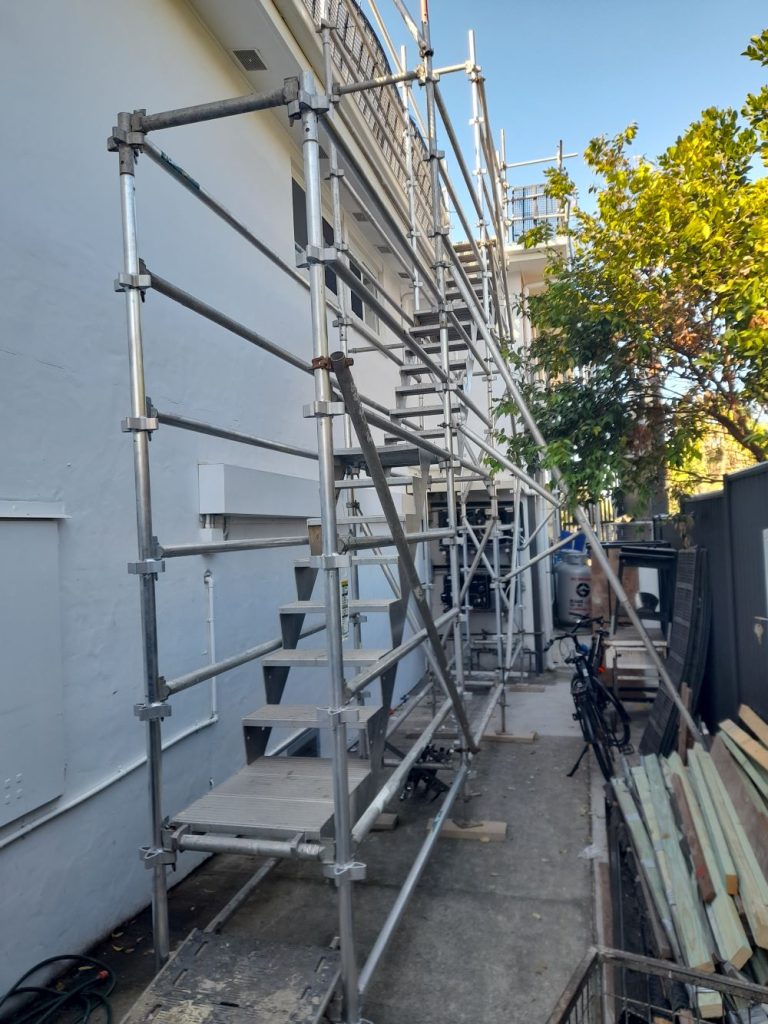If you have ever engaged in work involving scaffolding, you might have considered the practicality and safety implications of positioning a ladder atop it to reach elevated areas. While this approach may initially seem convenient, it is vital to thoroughly assess the critical safety concerns before proceeding. A comprehensive understanding of the potential risks and regulatory frameworks surrounding this practice is essential to safeguard not only your own well-being but also that of your colleagues within the work environment.
Though it may appear to be a straightforward solution, employing a ladder on scaffolding is EXCEEDINGLY hazardous. Introducing ANY extraneous items onto a stable scaffolding structure can significantly elevate the risks involved. The dangers associated with this practice are substantial, and it is crucial to ensure that safety remains the top priority over convenience in any construction context.
This article delves into the various reasons why placing a ladder atop scaffolding is not advisable, illuminating the potential hazards and outlining safer alternatives that should be considered for accessing heights without compromising safety.

Comprehending the Safety Risks Associated with Ladder Use on Scaffolding
The unequivocal answer is NO; using a ladder on scaffolding is NOT safe.
Employing a ladder on scaffolding introduces significant dangers that jeopardise the integrity and safety of the entire configuration. The primary purpose of scaffolding is to act as a secure and stable working platform that complies with stringent load-bearing requirements. When a ladder or any additional apparatus is placed on this structure, it can compromise the entire system's stability, thereby elevating the likelihood of accidents, falls, and severe injuries. Consequently, while it may initially appear to be a clever shortcut to reach higher areas, the potential hazards far exceed any perceived benefits.
Also Read: What NOT to Do When Using Scaffolding for Safety
Recognising the Specific Dangers of Ladder Use on Scaffolding
Having established that using a ladder on scaffolding is unsafe, let us closely examine the particular dangers that accompany this practice:
1. Instability of the Scaffolding Structure Due to Ladder Use
Scaffolding is meticulously engineered to serve as a safe and robust working platform, yet the introduction of a ladder can significantly disrupt this delicate balance. Ladders are designed to be positioned on solid ground rather than atop another structure. When a ladder is placed on scaffolding, it can destabilise the entire setup, substantially increasing the risk of falls, slips, or even catastrophic scaffold failure. This poses a serious threat not only to the user but also to anyone present in the vicinity of the work area.
2. Heightened Fall Risk Resulting from Increased Elevation
When working on scaffolding, you are already positioned above ground level. The addition of a ladder can further escalate this elevation, thereby amplifying the risk of falling. The precarious nature of using a ladder on scaffolding can lead to dangerous situations, particularly if the ladder shifts, slips, or fails to maintain stability. The potential for sustaining severe injuries rises dramatically with higher falls, making this practice exceedingly perilous.
Also Read: Who Is Responsible for Scaffold Hire and Safety?
3. Improper Ladder Angle Heightens the Risk of Accidents
Ladders are specifically designed to be utilised at designated angles to ensure safety during operation. Placing a ladder carelessly atop scaffolding prevents achieving the correct angle essential for maintaining stability. An improperly positioned ladder is prone to slipping or sliding, especially when placed on a surface that lacks adequate solidity and support. Moreover, scaffolding does not provide the same level of stability as a firm ground surface, making it challenging to secure the ladder at the appropriate angle, which further exacerbates the risk of accidents.
4. Absence of Secure Attachment Leads to Serious Hazards
When utilising a ladder on scaffolding, it often results in inadequate securing of the ladder itself. Most scaffolding configurations are not designed to accommodate ladders, meaning there is typically no reliable method to attach them securely. Although the ladder may appear stable initially, any movement, vibrations, or slips can rapidly lead to the ladder falling or tipping over, posing a significant risk not only to users but also to those nearby.
5. Non-Compliance with OSHA Safety Regulations Poses Legal Risks
When working on a construction site, adherence to safety regulations is frequently required. The Occupational Safety and Health Administration (OSHA) enforces rigorous guidelines concerning the safe utilisation of scaffolding and ladders. Improperly using a ladder on scaffolding can result in violations of OSHA standards (such as 1926.1053 for ladders and 1926.451 for scaffolds). Non-compliance can lead to legal repercussions, fines, penalties, or even project shutdowns, making it imperative to follow safety guidelines diligently.
6. Risks of Certification Nullification Due to Improper Usage
Every scaffolding installation undergoes a comprehensive certification process to ensure that qualified professionals have deemed it safe for use. Altering that setup by incorporating a ladder compromises its certification status. In the event of an incident, you may find yourself without coverage under work health and safety regulations. Lacking valid certification places you at significant risk, an unacceptable gamble that could lead to dire consequences.
Exploring Safer Alternatives for Reaching Elevated Areas
Now that we have thoroughly discussed the reasons against using a ladder on scaffolding, let us examine safer alternatives for achieving your desired height without sacrificing safety or violating regulations:
Utilise Built-In Scaffold Access Solutions to Enhance Safety
Most scaffolding installations come equipped with integrated access features, such as ladders or stairways. These access points are specifically designed to promote safety while navigating up and down the scaffolding structure. If your scaffolding includes these built-in access options, it is essential to take full advantage of them! They are meticulously engineered to work seamlessly with the scaffolding system, significantly enhancing overall security and minimising the likelihood of accidents occurring during use.

Consider Work Platforms or Extensions for Safe Access to Heights
An additional viable alternative is utilising a work platform or an extension. These solutions are specifically designed to provide a stable working surface while ensuring safe access to higher levels. They represent a far more secure option compared to attempting to balance a ladder on scaffolding. Work platforms are robust and certified for use in conjunction with scaffolding, ensuring your safety while facilitating the efficient and effective execution of tasks at elevated heights.
Final Insights on the Risks of Ladder Use with Scaffolding
So, can you safely position a ladder on scaffolding?
The definitive answer is no! Employing a ladder on scaffolding can lead to structural instability, increased fall risks, and violations of crucial safety regulations. The potential repercussions simply do not justify the associated dangers. Instead, make use of built-in scaffold access methods or opt for safer alternatives, such as work platforms. Always prioritise safety; the last thing you want is to jeopardise your well-being or that of others for the sake of convenience. Adhering to proper guidelines will ensure you remain safe and compliant while undertaking your tasks.
The Article: Ladder Safety on Scaffolding: What You Need to Know first appeared on https://writebuff.com
The Article Ladder Safety Tips for Scaffolding You Must Know Was Found On https://limitsofstrategy.com

